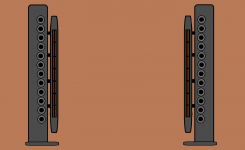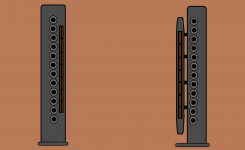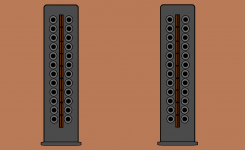Hi,
I'm about to build the panels for a OB line array project and wanted to ask about the side to side spacing of the mids and the tweeters. I'm aware that the closer the spacing the better, otherwise you can end up with hearing the sound emminating from two sources.
I was told by someone that some of this can be corrected through the use of a DSP and adjusting the timing of the drivers. Is this even possible?
I am triamping and use a MiniDSP. The speakers I plan to build are basically two-way and are augmented on the bottom with a pair of 15" subs.
Subs=20Hz to 70Hz
6.5" mids=70Hz to 3kHz
Planar tweeters=3kHz to 20kHz
I believe the distance between my mids and tweeter will end up being about 5" in my design. Here is a crude drawing of what I'd like to build If the distance issue can be corrected through my dsp.

Thanks in advance for any input,
Rob
I'm about to build the panels for a OB line array project and wanted to ask about the side to side spacing of the mids and the tweeters. I'm aware that the closer the spacing the better, otherwise you can end up with hearing the sound emminating from two sources.
I was told by someone that some of this can be corrected through the use of a DSP and adjusting the timing of the drivers. Is this even possible?
I am triamping and use a MiniDSP. The speakers I plan to build are basically two-way and are augmented on the bottom with a pair of 15" subs.
Subs=20Hz to 70Hz
6.5" mids=70Hz to 3kHz
Planar tweeters=3kHz to 20kHz
I believe the distance between my mids and tweeter will end up being about 5" in my design. Here is a crude drawing of what I'd like to build If the distance issue can be corrected through my dsp.

Thanks in advance for any input,
Rob
Adjacent line arrays will always have some horizontal polar response with nulls related to their distance apart. The farther apart or the higher the frequency of crossover, the narrower the good response angle between nulls.
DSP will let you dial in your time delay and move those nulls around (to aim the good response at the listener), but they are related to geometry and won't go away.
David
DSP will let you dial in your time delay and move those nulls around (to aim the good response at the listener), but they are related to geometry and won't go away.
David
Here is another drawing with a more basic version on the left.

It would be very generic and not unlike many others I've seen which is why I'm trying to depart from the norm a bit with the outboard array of planar drivers.
At this point, I'm only waiting on the 1 1/2" thick x 24" x 96" maple butcher block type surfaces to arrive next week. I plan to rip a 14" wide piece for the main body with a 4" wide piece for the outboard array.

It would be very generic and not unlike many others I've seen which is why I'm trying to depart from the norm a bit with the outboard array of planar drivers.
At this point, I'm only waiting on the 1 1/2" thick x 24" x 96" maple butcher block type surfaces to arrive next week. I plan to rip a 14" wide piece for the main body with a 4" wide piece for the outboard array.
Adjacent line arrays will always have some horizontal polar response with nulls related to their distance apart. The farther apart or the higher the frequency of crossover, the narrower the good response angle between nulls.
DSP will let you dial in your time delay and move those nulls around (to aim the good response at the listener), but they are related to geometry and won't go away.
David
So while the nulls won't go away, I might be able to mitigate some of their negative effect with my dsp?
Okay, I guess my best course of action at this point may to build a mock up of the outboard array and connect it to the mock up of the main body I already have in place. That way I can see what it sounds like and do some testing with my dsp.
Thanks for the help Dave,
-Rob
According to my book, a 3000 hz. crossover should be set at 4 1/2 inches center to center of the drivers. Keeps the lobing symmetrical...
________________________________________________________Rick.........
________________________________________________________Rick.........
I've no experience with line arrays, but I think that you will get all sorts of problems with diffraction with the outboard tweeters. Easy way to find out is to make up a proto with just one mid and one tweeter and try both outboard and conventional. I think you will see some nasty response issues with the outboard.
Tony.
Tony.
So while the nulls won't go away, I might be able to mitigate some of their negative effect with my dsp?
Okay, I guess my best course of action at this point may to build a mock up of the outboard array and connect it to the mock up of the main body I already have in place. That way I can see what it sounds like and do some testing with my dsp.
Thanks for the help Dave,
-Rob
Actually trying out your ideas with a few mock-ups is highly recommended! There is nothing like actually experiencing how different ideas can affect the sound and source location. We used to use a lot of cardboard boxes making different mock-ups and doing trial and error experiments, It's fun, it's cheap and you can certainly learn a great deal using the hands-on method.
Best Regards,
TerryO
According to my book, a 3000 hz. crossover should be set at 4 1/2 inches center to center of the drivers. Keeps the lobing symmetrical...
________________________________________________________Rick.........
Yes, and I should have a problem right now with the center to center spacing of my 6 1/2" drivers running them up to 3000Hz but I'm just not hearing it. I know I should but even at just 12 feet away from the speakers, they sound good to my ears. On my next set of arrays I'll look for some 4" drivers.
I've no experience with line arrays, but I think that you will get all sorts of problems with diffraction with the outboard tweeters. Easy way to find out is to make up a proto with just one mid and one tweeter and try both outboard and conventional. I think you will see some nasty response issues with the outboard.
Tony.
I think you're right. If This ends up being the case I'll have to go with plan B and mount them next to each other in the same baffle.
Actually trying out your ideas with a few mock-ups is highly recommended! There is nothing like actually experiencing how different ideas can affect the sound and source location. We used to use a lot of cardboard boxes making different mock-ups and doing trial and error experiments, It's fun, it's cheap and you can certainly learn a great deal using the hands-on method.
Best Regards,
TerryO
I think it will be educational for me to hear it first hand. Plus it will give me a much better understanding of the driver interaction. I'm sure my second go at a line array will be better than this one. 😀
Your left pic of post4 looks more "right".
I have the "feeling" that the closer you get the drivers to each other the wider the lobe into your "stereo" seat. And the further you can move your head without entering the "null" on ether side of the stereo spot.
I have the "feeling" that the closer you get the drivers to each other the wider the lobe into your "stereo" seat. And the further you can move your head without entering the "null" on ether side of the stereo spot.
I suspect so too. It may be possible to arrange some felt around the tweeters to give them an outboard look without the edges.I think you're right.
I decided to forgo the original design in favor of a more basic, single baffle design in the interest of better sound. I'll post a couple pics when I'm done.
This is a multiple line array done right and when set up such that they are angled to give a 'close enough' time correct offset between each 'array' at the LP, DSP isn't required: McIntosh XR290 Speaker System
GM
GM
I did the final production crossover of the 290 after Roger retired. It is essentially a sideways 3way of Linkwitz/Riley type. If I remember right the system performance was a little better with the tweeters inside.
David
David
Interesting! I guess it depends on the room, orientation as it sounded best with the tweeters on the outside in a mostly temper glassed room same as what I found worked best overall when mating a 'super' tweeter to 'FR' drivers.
Regardless, it's the most impressive point source multi-way speaker I've auditioned regardless of price to date.
GM
Regardless, it's the most impressive point source multi-way speaker I've auditioned regardless of price to date.
GM
Interesting! I guess it depends on the room, orientation as it sounded best with the tweeters on the outside in a mostly temper glassed room same as what I found worked best overall when mating a 'super' tweeter to 'FR' drivers.
Regardless, it's the most impressive point source multi-way speaker I've auditioned regardless of price to date.
GM
I'm just thinking in terms of anechoic response smoothness. It may well be that you got best performance in your room with tweeters outside. Certainly image width is typically wider with tweeters outside.
My favorite Mac speaker of this era is stil the XRT 24. Very well integrated sound and very cool styling.
David
I did the final production crossover of the 290 after Roger retired. It is essentially a sideways 3way of Linkwitz/Riley type. If I remember right the system performance was a little better with the tweeters inside.
David
David,
Do you recall what the crossover points were? I read somewhere on the net that it was 400Hz and 1300Hz. Does that sound about right? At that low of a crossover point it would keep combing at bay.
This is my first speaker build and I'm using what I had on hand so for the mids I'm using 6 1/2" drivers and crossed from 70Hz to 3200Hz which given the high frequencies should be inducing a great deal of combing. I'm sure measurements could be taken that would indicate combing but I'm just not hearing it. I'll choose smaller midranges next time around but for this build they seem to be working.
Also, it looks like there is about 6" of distance center to center between the mids and the tweeters on the 290. Looking at the pictures of the 290 it looks like the spacing could have been reduced to 3 1/2" to 4". Do you recall if there was a reason not to mount them closer to each other?
-Rob
Hi Rob. I don't specifically recall the crossover points. 400 sounds plausible but 1300 might be low? Thats pushing a 1" dome but on the other hand the low end gain of the array would be considerable.
Center to center spacing could have been reduced but it wasn't a priority at Mac at the time. Roger did the layout and didn't worry about phasing issues. His design approach was to adjust power response in a reverb room where phasing generally doesn't show.
The XRT 20 had the tweeter line totally seperate from mid and woofs, leaving spacing indeterminate. I tried to get the lines unified in a later model but the Japanese balked, so I put a phase switch on the tweeters so that you could choose the best polarity. Recent models have a more sensible layout with lateral mid/tweeter/mid lines.
Regards
Center to center spacing could have been reduced but it wasn't a priority at Mac at the time. Roger did the layout and didn't worry about phasing issues. His design approach was to adjust power response in a reverb room where phasing generally doesn't show.
The XRT 20 had the tweeter line totally seperate from mid and woofs, leaving spacing indeterminate. I tried to get the lines unified in a later model but the Japanese balked, so I put a phase switch on the tweeters so that you could choose the best polarity. Recent models have a more sensible layout with lateral mid/tweeter/mid lines.
Regards
Thanks for sharing your information Dave. Now you've got me wondering if I should add another line of mids to make a MTM array. I thought of doing that and have seen several pictures like that but thought it would limit the horizontal dispersion of the tweeters.
What is your opinion regarding doing this with the 6 1/2" drivers I'm using with regard to the distance from mid drivers on one side vs the mid drivers on the other side of the tweeters? I'd have a lateral center to center distance of about 9 1/2" between each line of mids and they are crossed pretty high at 3k to 3.3kHz.
Do you see this as a deal breaker for the MTM in my scenerio? If not, I'd love to build them in MTM.
Thanks,
Rob

What is your opinion regarding doing this with the 6 1/2" drivers I'm using with regard to the distance from mid drivers on one side vs the mid drivers on the other side of the tweeters? I'd have a lateral center to center distance of about 9 1/2" between each line of mids and they are crossed pretty high at 3k to 3.3kHz.
Do you see this as a deal breaker for the MTM in my scenerio? If not, I'd love to build them in MTM.
Thanks,
Rob

Last edited:
Not a deal breaker.
Mounting the lines as a lateral MTM will not get rid of lobes but it will force symmetry, which is a good thing. We generally can't get drivers close enough to prevent all lobing. This would require a spacing of less than 1/2 wavelength and having an MTM typically doubles the total span.
Anyhow, scrunch the drivers tight to push the lobes out as much as is practical.
Regards
Mounting the lines as a lateral MTM will not get rid of lobes but it will force symmetry, which is a good thing. We generally can't get drivers close enough to prevent all lobing. This would require a spacing of less than 1/2 wavelength and having an MTM typically doubles the total span.
Anyhow, scrunch the drivers tight to push the lobes out as much as is practical.
Regards
- Status
- Not open for further replies.
- Home
- Loudspeakers
- Multi-Way
- Distance between mid and tweeter?